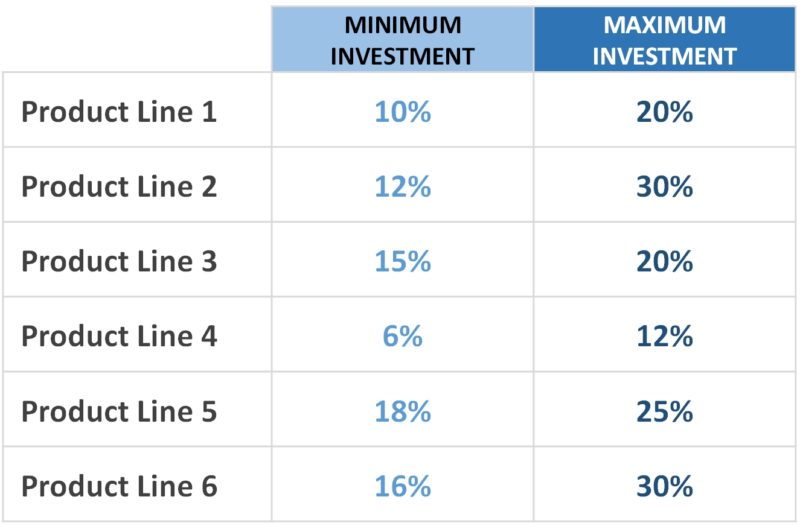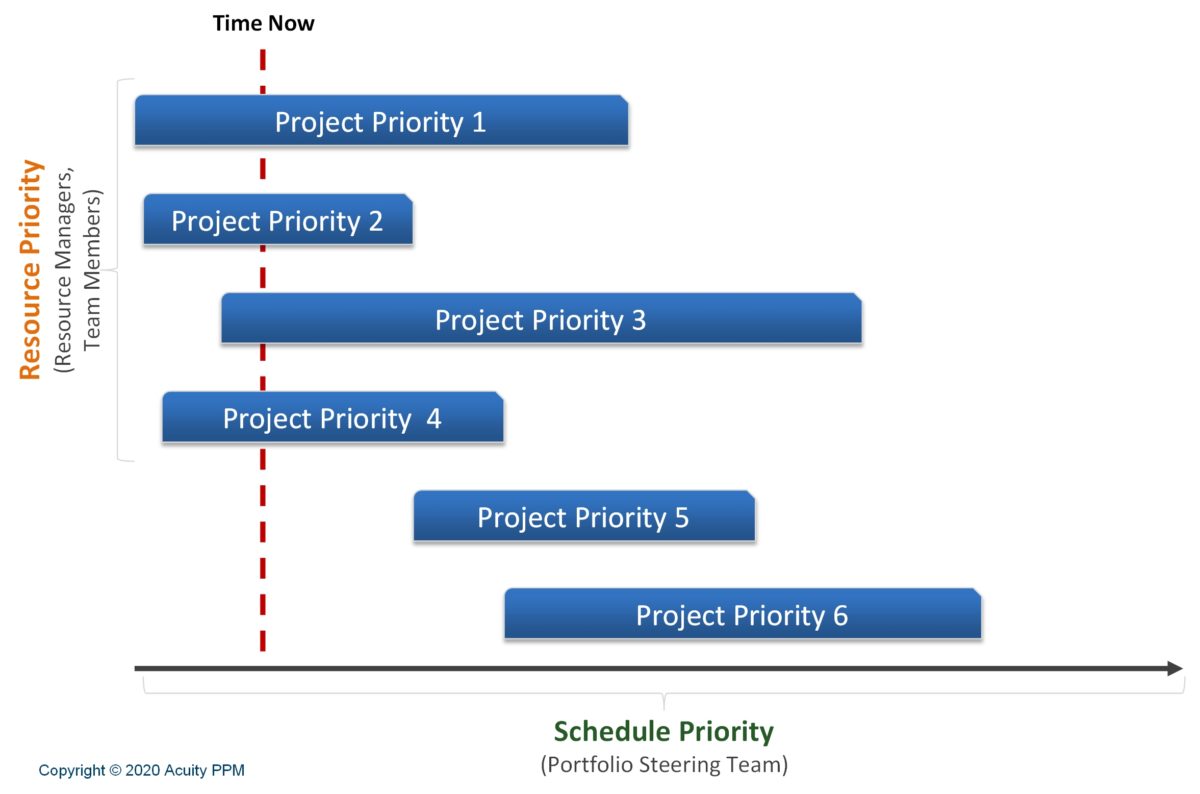Project Portfolio Optimization
Introduction to Project Portfolio Optimization
Project portfolio optimization offers the promise of generating and delivering the maximum possible business value from the company’s project portfolio. By using data and advanced analysis techniques, organizations can often generate more business value (+20%) with the same budget and resources as they can using manual processes. Project portfolio optimization stems from financial portfolio management theory and is one of the most advanced processes of project portfolio management.
To optimize means to “make the best or most effective use of a situation, opportunity, or resource” (Dictionary.com). In simple terms, optimization is about doing the best we can with what we’ve got. Another way to look at is “bang for the buck”. Virtually every company has limited resources, and the goal is to generate as much business value (“bang”) with the limited resources available (“the buck”).
Optimizing a project portfolio is to construct an optimal portfolio given current limitations and constraints. Portfolio optimization heavily emphasizes the “science” of project portfolio management and is very much data driven and relies on advanced analysis. This is why our PPM maturity model includes portfolio optimization starting at level 3 maturity. Before this, most organizations simply do not have established processes to enable portfolio optimization techniques.
Portfolio optimization is part of the second component of the project portfolio lifecycle, ‘Optimize Portfolio Value’. The goal of project portfolio management is to help organizations deliver maximum business value. Processes such as prioritization and managing resource capacity help us to “make the best or most effective use of human resources”. In this way, organizations can increase business value delivery. However, while these processes may help leaders to construct a ‘good’ project portfolio, it likely does not produce the best (or optimal) results. This is why portfolio optimization very often deliver greater value with the same resources and budget. That’s powerful.

The Different Types of Project Portfolio Optimization
An “optimal” portfolio for your organization will depend upon the goals of your portfolio. Not every organization will optimize their portfolio in the same way, but there are four basic types of portfolio optimization:
- Cost-Value Optimization: this is the most popular type of portfolio optimization and utilizes efficient frontier analysis. The basic constraint of cost-value optimization is the portfolio budget.
- Work Type Optimization: this is a lesser known way of optimizing the portfolio, but corresponds to a more common term, portfolio balancing. The basic constraints of work-type optimization are categorical designations.
- Resource Optimization: this is another effective way of optimizing the portfolio and utilizes capacity management analysis. The basic constraint of resource optimization is human resource availability.
- Schedule Optimization: this type of optimization is associated with project sequencing, which relates to project interdependencies. The basic constraints of schedule optimization are project timing and project dependencies.
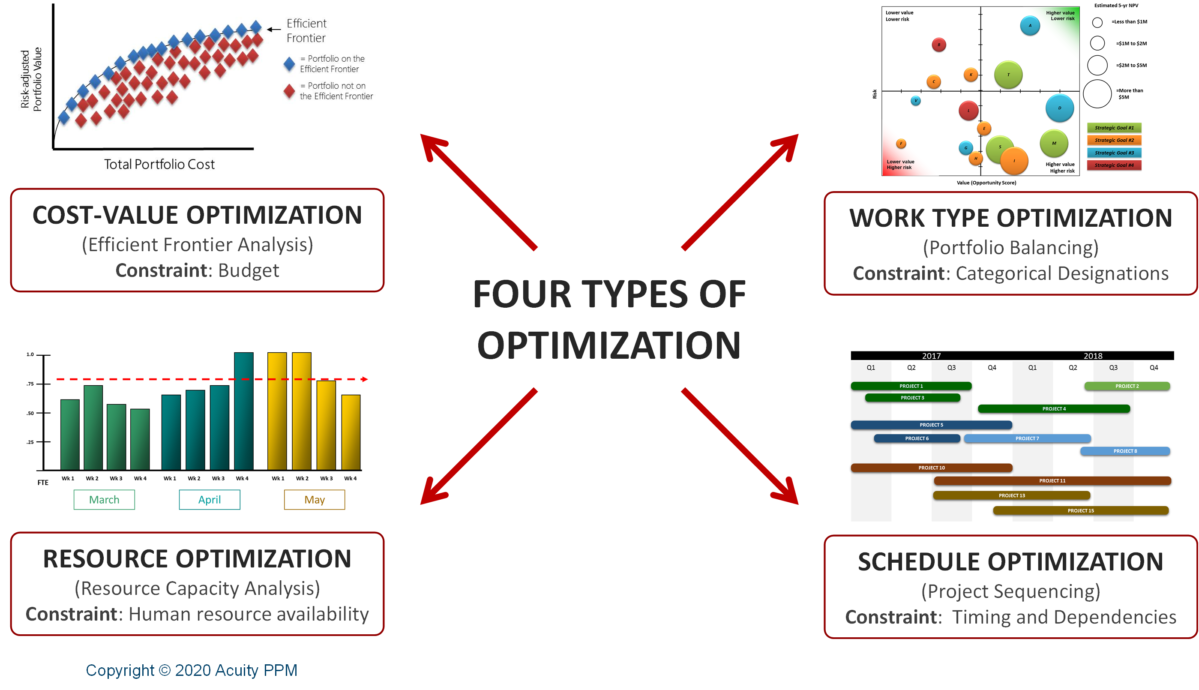
These four types of optimization are actually advanced versions of foundational portfolio management disciplines. Prioritization as a selection technique becomes cost-value optimization. Portfolio balancing becomes work type optimization. Resource capacity planning becomes resource optimization. Project sequencing becomes schedule optimization. The chart below highlights that the cost-value and work type optimization techniques are used to improve project selection whereas resource and schedule optimization are used to build a realistic portfolio.

Companies do not need to use every technique, but utilizing multiple methods can produce the most optimal portfolio for your organization. In order to successfully optimize a portfolio, two key things are needed: the right data, and the right constraints. Without sufficient data, the portfolio cannot be optimized. From this angle, collecting a sufficient amount of the right data is directly tied to organizational maturity. Less mature organizations will not have the discipline or processes in place to collect enough good data. Data is the fuel that makes the portfolio engine run; without enough good data, there is insufficient “power” to optimize the portfolio. Moreover, if the data is not refreshed with some regularity, the optimization outputs become stale. Mature organizations will collect good data during Work Intake and have other processes in place to regularly input new project data into its portfolio system, enabling it to optimize the portfolio on a recurring basis.
In addition, the right constraints need to be identified, understood, and communicated among the portfolio governance team. A constraint is a limitation imposed upon the organization or a restriction set by the portfolio governance team. Without acknowledging and identifying key constraints, it is not possible to optimize the portfolio and maximize organizational value. Each aspect of portfolio optimization has its own constraints and will be discussed in more detail below.
Cost-Value Portfolio Optimization (aka Efficient Frontier Analysis)
One of the basic tenets of project portfolio management (PPM) is to maximize the value to the organization through its projects. This can be accomplished through traditional cost-value optimization (most commonly known as finding the ‘efficient frontier’). The goal is to identify the combination (or mix) of projects that generates the most business value for a given budget level. In other words, if you have a $30 million dollar project budget, how much more business value can you generate compared to a $25 million dollar budget? You should be able to generate far more value, but the key is to select the right combination of projects to unlock that value. Cost-value optimization can potentially increase portfolio value by 20% without making any additional investments.
Cost-Value Optimization is a Superior Project Selection Technique
Cost-value optimization is a superior project selection technique. In our article on prioritization, we discussed a very common approach for rank ordering projects and selecting projects from top to bottom until budget ran out. This approach will yield a reasonably good result, but it will not produce the best result. Simply prioritizing projects and “drawing the line” when you run out of budget will not unlock maximum value. What most organizations fail to do is identify the best overall combination of projects to maximize business value. In fact, it is possible for two lower priority projects together to deliver more business value than one higher priority project. Richard Bayney, in his article “Creating a Portfolio of Prioritized Projects”, does a great job of showing how rank ordering produces an inferior portfolio selection result to portfolio optimization. Cost-value optimization requires senior leaders to reframe project selection by focusing on maximizing business value, not merely selecting only the highest ranked projects.
With cost-value optimization, the basic constraint is the organizational budget for projects. In most cases, organizations will have a fixed total project budget, or at least a strong estimate of how much it can spend over a given year or period. For those organizations that may not have a fixed budget, efficient frontier analysis can still provide target portfolios at different cost points.
The Efficient Frontier
Traditional portfolio theory (used for financial portfolios) applies the concept of an “efficient frontier” (figure below), the points at which for a given amount of investment there is an optimal portfolio providing maximum benefit.
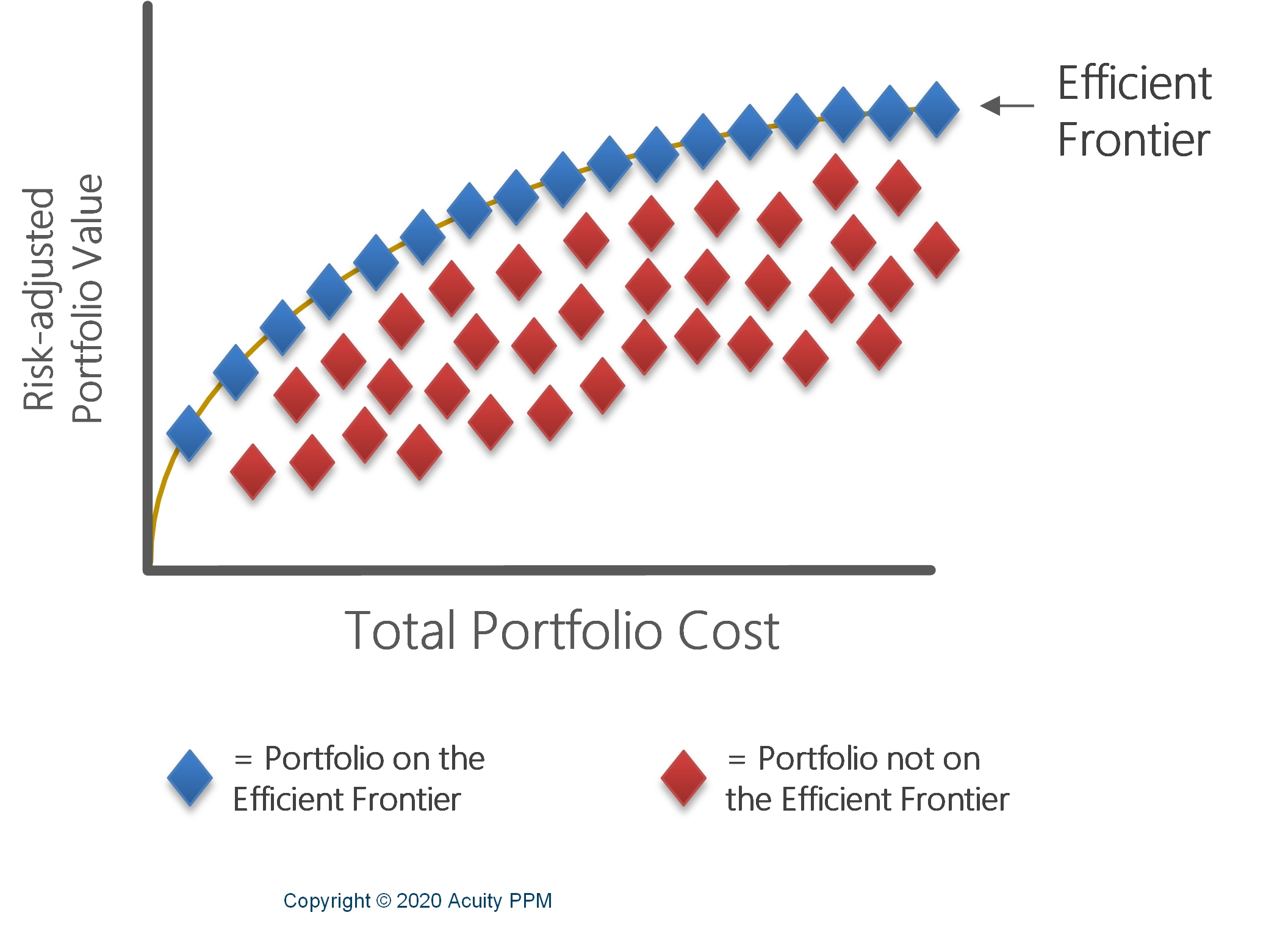
Lee Merkhofer, a portfolio management expert, has this to say about using the efficient frontier for portfolio optimization: “In the context of modern portfolio theory, the efficient frontier is the bounding curve obtained when portfolios of possible investments are plotted based on risk and expected return. The efficient frontier shows the investment combinations that produce the highest return for the lowest possible risk. A portfolio that is not on the efficient frontier is said to be ‘inefficient’ because another portfolio exists that has lower risk for the same return. The goal for selecting projects is to pick project portfolios that create the greatest possible risk-adjusted value without exceeding the applicable constraint on available resources. Economists call the set of investments that create the greatest possible value at the least possible cost the ‘efficient frontier.’ Most organizations fail to find the best project portfolios and, therefore, do not create maximum value. Inability to find the efficient frontier is [another] reason organizations choose the wrong projects.” Portfolio Managers and Portfolio Governance Teams should under the portfolio risk tolerance thresholds in order to optimize risk and value in the portfolio.
As much as companies want “data-driven decision making”, if the optimization outputs are contrary to their expectations, they will have a harder time accepting the results. Open discussion is needed to level set expectations with leadership.
In the example below, we can see a portfolio (red diamond) that is not on the efficient frontier. For the same budget, this portfolio could generate far greater value. At a lower budget, this portfolio could generate equal value. Although most organizations prefer to maximize the value for their maximum budget target, this view is useful to keep in mind for executives to understand that senior leaders often leave money on the table or pay too much for the value they are getting.
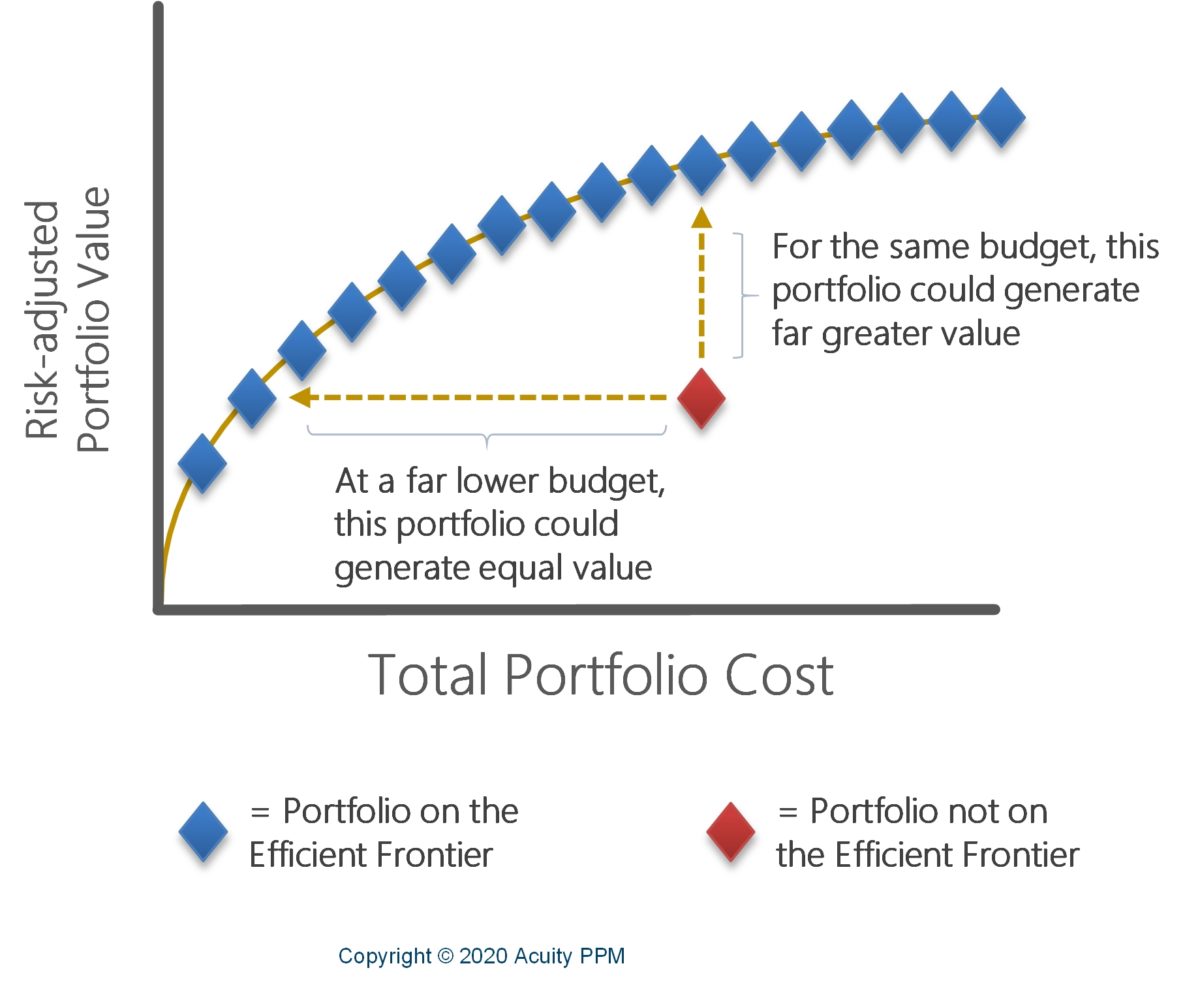
Here are three more views to conclude our discussion on the efficient frontier. In my experience, I have seen many companies simply try to approve everything on their list. This would put a portfolio in the upper right corner of the efficient frontier. There are significant diminishing returns as you approach that spectrum of the efficient frontier. Usually all those extra projects are low-value ‘nice to have’ projects that consume resources but add very little value. Companies need to be careful of those types of projects. At the other end, some companies may make exceptional budget cuts and lose opportunities to deliver business value. At that end of the spectrum, even modest increases in portfolio budget can lead to far more business value. There is a careful balance when applying efficient frontier analysis and we will cover these challenges at the end of this article.
You Must Define Portfolio Value
Traditional portfolio theory assumes project and portfolio value is strictly a financial value. However, project value should also include several qualitative (or intangible) benefits that are not measured strictly by net present value (NPV) or return on investment (ROI). The portfolio’s value should also correspond to strategic delivery and accomplishing the strategic goals of the organization.
Be sure to refer back to our article on prioritization. There, we covered the importance of having the portfolio governance team define ‘value’, which will differ at every company. Once value is defined, a scoring model can be created to evaluate project value. These prioritization ‘scores’ represent relative project value and can then be used to optimize the portfolio. Without defining value, senior leaders will only be able to optimize the portfolio from a purely financial standpoint, and this will not lead to optimal strategic results. By factoring in strategic alignment and other business drivers, a better assessment of project value can be produced and used to optimize the project portfolio.
The application of the efficient frontier approach can save the portfolio governance team time on project selection because it focuses on the set of projects that delivers maximum value for a particular level of spending. Instead of fighting for what should be included, the discussion can be focused on those projects that bring the portfolio off of the efficient frontier (such as mandatory projects that don’t provide much value). To use a golf analogy, using the efficient frontier will not give you a ‘hole in one’ (i.e. it won’t give you the final answer), but it will get you to the putting green nearly every time in one stroke (i.e. save time by getting very close to the final answer). Every golfer would take that.
Work Type Portfolio Optimization
A complementary optimization approach to improve project selection is what we refer to as work type optimization. Essentially, this type of optimization helps ensure a balanced investment across the portfolio and can be used in conjunction with cost-value optimization. The concept of ‘portfolio balance’ is quite common in PPM literature. We see it come up in relation to risk-value bubble charts in order to visualize the portfolio and ensure that senior leadership is not overinvesting in low-value or high-risk areas.
Balance can also support a distributed investment strategy across:
- Business units
- Product lines
- Categories (such as run, grow, transform)
- Strategic goals
In order to optimize the portfolio according to work types (or categories) the portfolio governance team needs to set investment ranges across the categories they want to optimize against. The simple table below captures the investment range that a portfolio governance team may want to put into each of its six product lines. These values are used as part of an optimization algorithm to ensure an acceptable balance of investment. If the ranges are too narrow, it can limit the options available to the portfolio governance team.
Optimizing a project portfolio is to construct an optimal portfolio given current limitations and constraints. Portfolio optimization heavily emphasizes the “science” of project portfolio management and is very much data driven and relies on advanced analysis.
Resource Optimization
Resource optimization takes a different approach to optimizing the portfolio by addressing resource constraints that exist in practice. Resource optimization focuses on resource utilization and availability in order to construct a realistic portfolio that can be achieved and delivered. One of the shortcomings of cost-value optimization is that it does not directly incorporate resource availability and utilization into the analysis. That approach may yield an optimal portfolio from a value perspective but one that is unrealistic to deliver because of known resource constraints.
Resource optimization is an extension of resource capacity planning. In our article on the challenges of managing resource capacity we covered that good project planning is the foundation of capacity planning; without reasonable project planning capacity planning is simply not possible. As long as there is reasonable project planning with good enough resource estimates, some level of resource optimization is possible. We will briefly touch two approaches.
Approach #1 – Annual Utilization
A simpler approach that organizations can get started with is to optimize a few key resources at an annual planning level. This involves estimating the resource utilization for each role for each project for a given fiscal year. As long as there is some reasonable understanding of the true capacity of each role, an optimal combination of projects can be found to fit within known resource constraints.
One of the primary benefits of this simplistic approach is that companies can more easily determine how many projects could realistically be worked on over the course of a year. However, there are multiple down sides. This approach does not take into account the timing of when resources are needed, so there may still be periods of time with unrealistic workloads due to the timing of the projects. It also assumes that the resource estimates are reasonably good; when attempting to optimize the portfolio at such a high level, even minor changes to resource estimates could greatly change the mix of projects selected as part of the optimization. Nevertheless, this approach can help support annual planning exercises.
Approach #2 – Time phased resource plan
Optimizing against a time-phased resource plan is more advanced, harder to do, but will produce a better output. This approach assumes that a month by month resource plan is prepared with good resource forecasts. This can be done manually through scenario planning, but only specialized software can support genuine resource optimization. Please note that we are not referring to ‘resource leveling’, which is where resource loads are smoothed out but project durations are extended. This is not resource optimization. Rather, we are focused on sequencing projects according to resource utilization and capacity in order to minimize over-utilized resources. The graphic below highlights that re-sequencing projects across the portfolio can reduce over-utilization and perhaps even remove unnecessary projects in order to free up critical resources.
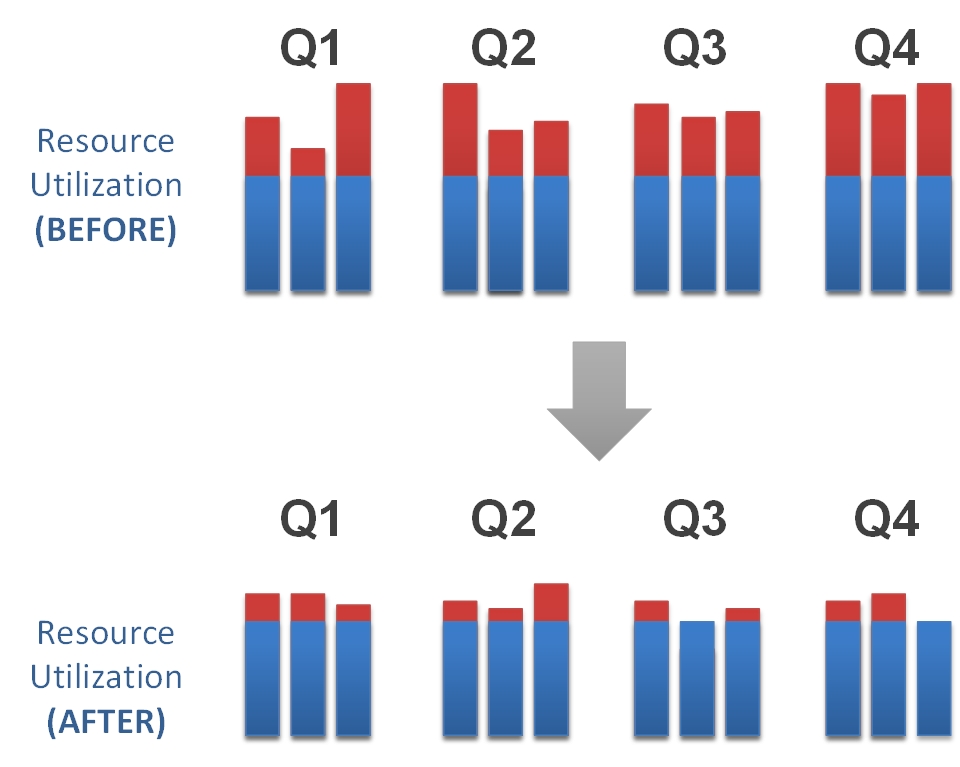
Schedule Optimization
The last type of portfolio optimization is schedule optimization in a multi-project environment. This accounts for all project interdependencies across projects. In relation to project sequencing, organizations should also account for project priorities and resource availability (see graphic). There are at least two approaches that we will highlight below.
Multi-Project Critical Path
Some organizations may load dependencies between projects into a master integrated schedule and apply critical path scheduling to create the best scheduling network across projects. This is a fair approach that can help teams improve scheduling across projects.
Multi-Project Critical Chain
We believe that an even more valuable approach is to account for critical bottleneck resources. This is where Critical Chain Project Management (CCPM) can be very effective for optimizing the schedules of multiple projects across the portfolio.
Critical Chain Project Management originates from the Theory of Constraints which emphasizes that every system has a bottleneck or ‘constraint’ which limits the output (throughput) of a good or service. Critical Chain Project Management is a project management application of the Theory of Constraints that recognizes that a small number of key resources (‘bottleneck resources’) are the key constraints to completing project work on time. When Project Managers understand the resource constraints and schedule according to it, they can achieve fantastic results.
Applying Critical Chain Project Management combines both resource optimization and schedule optimization together. It prioritizes the scheduling of tasks that utilize bottleneck resources in such a way that the bottleneck resources are not over-utilized while still accounting for other schedule dependencies and relationships across project schedules. There are a number of other important principals associated with CCPM (such as buffer management) that are beyond the scope of this article, but are important for successfully adopting CCPM.
Challenges of Project Portfolio Optimization
We will now turn our attention to the challenges associated with portfolio optimization. As we mentioned at the beginning, project portfolio optimization requires more advanced processes and is often initiated as organizations reach level 3 maturity according to our portfolio maturity model. While project portfolio optimization can help organizations maximize business value delivery, there are a number of challenges that must be addressed in order to see these benefits.
Getting leadership support of the outputs
The first major challenge is getting senior leaders to support the outputs of any optimization. With cost-value optimization, the recommended portfolio may not match leadership expectations. In fact, two lower priority projects may be favored by the optimization model over one higher priority project, which will likely frustrate the sponsor of the higher priority project. As much as companies want “data-driven decision making”, if the optimization outputs are contrary to their expectations, they will have a harder time accepting the results. Open discussion is needed to level set expectations with leadership.
One way of getting around this is to use cost-value optimization to create two or three portfolio scenarios to let senior leaders discuss the merits of one portfolio scenario over another. Or, an optimization approach will likely include some of the same projects across all three scenarios. From there, the portfolio governance team can weigh in on the projects that were included in one of the scenarios but not all three and then make a final decision on the smaller set of projects. Leadership should also learn to challenge any projects that bring a portfolio off of the efficient frontier. In this way, the portfolio governance team can learn to maximize portfolio value.
The portfolio optimization models cannot factor in all criteria
Another challenge is where an optimization model cannot possibly account for all of the decision criteria. In some cases, project selection involves some very unique criteria that would otherwise be hard to model. Selecting a portfolio based on a few factors will undoubtedly omit some very important decision criteria that the leadership team understands. Examples of this can include company mandates, regulatory compliance, or other work required to keep the business running. These types of projects may get excluded from cost-value optimization because they have lower business value but still have other criteria that requires them to be done. Organizations may choose to exclude all mandated projects from cost-value optimization analysis and simply adjust the budget accordingly.
Collecting enough data and having the right data at the right time
One critical success factor for making portfolio optimization successful is to have “lean” processes that make it reasonably easy to collect project and portfolio data and use the data to optimize the portfolio. If organizational processes are too cumbersome, or if the data is too hard to collect, the portfolio optimization process will be less valuable and likely replaced with less effective (but easier) processes.
Not having enough options to choose from
At some companies, a proposed list of projects is submitted that just meets the planned budget. In this case, there are no alternatives to choose from and therefore no optimized portfolio. The portfolio governance team should have at least a few options to choose from in order to select the best portfolio possible. By approving everything on the list, there is no way to optimize the portfolio from a cost-value perspective.
Ironically, having too many options to choose from can also create challenges. When there are too many options, even subtle changes to cost-value optimization criteria and project inputs (such as project budget) can produce greatly different results. Be mindful of having too many project options; even without utilizing optimization techniques it can be difficult for decision makers to agree on a project portfolio when there are too many projects to choose from.
Developing the right cadence for portfolio optimization
Since optimization techniques can change the composition of the portfolio or the sequencing of projects and resources, additional consideration needs to be given to the frequency of utilizing optimization techniques. Cost-value optimization might be used for annual planning, but what about project requests that come in during the year? Will optimization be used throughout the year? And how does the portfolio governance team handle active projects that are no longer part of the optimization output? Portfolio Managers need to draw up guidelines for how optimization techniques will be used and applied, otherwise portfolio optimization can potentially disrupt project delivery.
Not having internal expertise portfolio optimization
Finally, companies may not have sufficient internal expertise to successfully optimize the portfolio even if all the data is available. Project portfolio optimization does require the right data analysis skills. Companies that lack this skill set internally should get outside help with optimizing the portfolio. In the future, we believe that Artificial Intelligence and Machine Learning will greatly improve portfolio optimization.
How To Get Started With Portfolio Optimization
The most important factor for successfully utilizing portfolio optimization techniques is to have good quality data with agreed upon constraints. This includes an organization’s ability to translate their strategic goals and objectives into meaningful business drivers that can be incorporated into an optimization model. Your Portfolio Manager plays a critical role with developing and establishing portfolio optimization processes. Here are some steps to take to get started with each dimension of portfolio optimization:
Cost-Value Portfolio Optimization
- Establish a robust prioritization scoring model – this will enable the portfolio governance team to clearly evaluate a project’s value. This will include qualitative factors such as alignment to strategic goals and other business drivers. The resulting output, the value score, can then be utilized for cost-value optimization.
- Establish good project planning – make sure the project teams fully understand the scope and cost of their project. Otherwise, portfolio optimization will be far less effective. At the very least, make sure that project scope is reasonably well understood and a reasonable cost estimate can be produced. Again, if project costs change over time due to changing scope, this can interfere with effective optimization.
- Establish ground rules for how portfolio optimization will be used – this includes training leadership on how portfolio optimization works and get agreement for how optimization results will inform final portfolio selection.
- Conduct optimization – this may entail building a model a spreadsheet or use of other sophisticated software.
Work Type Portfolio Optimization
- Define categorical designations – companies ready to begin applying optimization techniques probably already have sufficient categorical designations, but if not, be sure that everyone on the portfolio governance team understands the categorizations. For example, run/grow/transform is a common paradigm, but many companies still struggle to categorize projects because the definitions are not well understood.
- Ensure each project is categorized – this is a data integrity step to ensure that all projects are categorized appropriately.
- Define investment ranges for each category – the portfolio governance team needs to agree on investment ranges for each work type (e.g. category, business unit, strategic objective, product line, etc.).
- Conduct optimization – this may entail building a model a spreadsheet or use of other sophisticated software.
Resource Optimization
- Establish good project planning – we covered this in great detail in our article on resource capacity planning. Project teams must know how to create a project plan with scope, activities, dependencies, duration estimates, and resource estimates. Without this, both capacity planning and resource optimization are not possible. This may require dedicated training by the Project Management Office (PMO).
- Create a resource plan for each project – at the very least, overall resource estimates should be compiled in order to conduct the simpler version of resource optimization. For advanced resource optimization, a time phased resource plan is needed as well as sophisticated software to handle this type of optimization.
- Conduct optimization – this may entail building a model a spreadsheet or use of other sophisticated software.
Schedule Optimization
- Define good integrated scheduling practice – simplified project management and project tools will not work with full schedule optimization. Project Managers need to be well versed in how to create an integrated schedule that can calculate a critical path (or utilize Critical Chain Project Management).
- Establish a process to create a multi-project view – in order to optimize schedules across a portfolio, all project scheduling data needs to be linked.
- Prioritize projects to support sequencing – the most important projects should take schedule priority over lower value projects.
- Incorporate bottleneck resources (if using Critical Chain) – Critical Chain Project Management does an excellent job of combining resource optimization and schedule optimization together, but portfolio governance teams need to agree on which key resources should be included in this analysis.
- Conduct optimization – this requires the use of sophisticated scheduling software.
Sample Process for Optimization
The diagram below represents a sample approach for handling portfolio optimization.
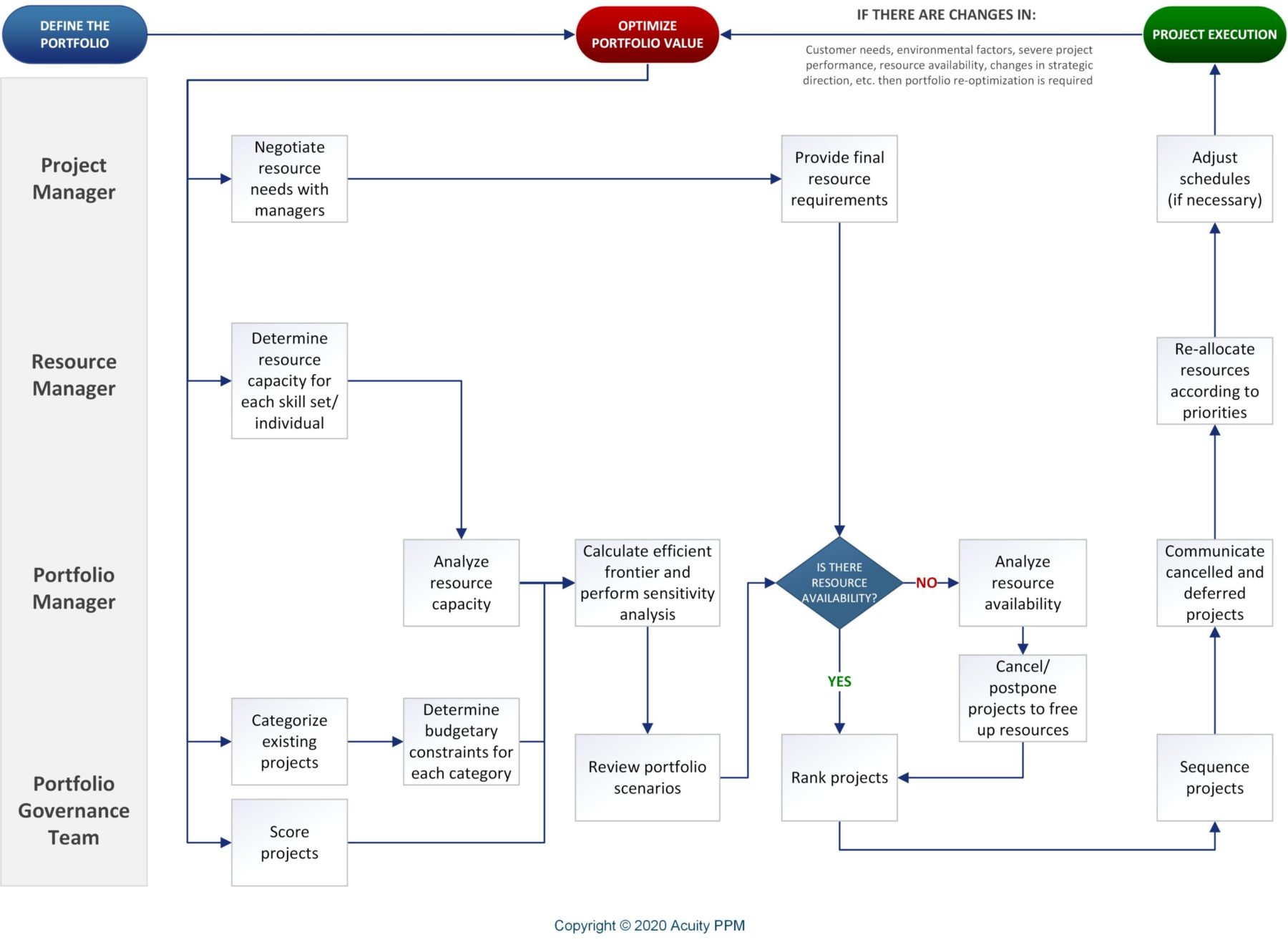
- The Project Manager will negotiate resource needs with Resource Managers based on the project plan.
- The Resource Manager will determine the resource capacity for each requested individual.
- The Portfolio Manager will analyze resource capacity.
- The Portfolio Governance Team will categorize existing projects and determine budgetary constraints for each category.
- The Portfolio Governance Team will also score each project (if not already done) using their prioritization scoring model.
- The Portfolio Manager will take these inputs and perform portfolio optimization and conduct sensitivity analysis.
- The Portfolio Governance Team will review the scenarios created by the Portfolio Manager.
- Project Managers will provide final resource requirements (if not done earlier)
- The Portfolio Manager will evaluate resource availability and recommend certain projects to be cancelled or postponed if resource availability is inadequate.
- The Portfolio Governance Team will decide if any projects need to be cancelled or deferred and then finish ranking projects and support project sequencing.
- The Portfolio Manager will help communicate any projects that have been cancelled or deferred.
- Resource Managers will re-allocate their resources according to updated priorities.
- Project Managers will adjust schedules as needed in support of priorities, resources, and sequencing.
- Project delivery continues.
A Portfolio Manager should actively monitor the portfolio and recommend another optimization exercise when certain criteria are met. The list below highlights several conditions during project execution that may prompt the portfolio to be re-optimized:
- New project requests are proposed
- Significant changes occur in the business environment
- Customer needs change
- Business emergencies impact project(s)
- Project performance deteriorates
- Resource availability changes
- Strategic direction changes
VIDEO: Project Portfolio Optimization
Portfolio Optimization Summary
Project portfolio optimization can greatly increase portfolio value and significantly increase the likelihood of success, but the techniques required are typically performed by more mature organizations. Establishing good portfolio management discipline lays the foundation for solid portfolio optimization. Companies should be encouraged to mature their processes in order to be able to utilize different optimization techniques. Project portfolio optimization relies heavily on the “science” of PPM, but good leadership (“the art”) is needed in order to successfully apply optimization outputs. While lower maturity organizations may be able to complete a one-time optimization exercise with the help of an outside expert, higher maturity is needed in order for companies to perform these advanced portfolio optimization techniques consistently on their own.
Tim is a project and portfolio management consultant with over 15 years of experience working with the Fortune 500. He is an expert in maturity-based PPM and helps PMO Leaders build and improve their PMO to unlock more value for their company. He is one of the original PfMP’s (Portfolio Management Professionals) and a public speaker at business conferences and PMI events.
[activecampaign form=3]
What is project portfolio optimization?
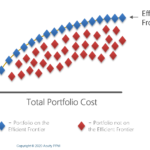
Optimizing a project portfolio is to construct an optimal portfolio given current limitations and constraints. To optimize means to “make the best or most effective use of a situation, opportunity, or resource” (Dictionary.com). In simple terms, optimization is about doing the best we can with what we’ve got. Another way to look at is “bang for the buck”. Virtually every company has limited resources, and the goal is to generate as much business value (“bang”) with the limited resources available (“the buck”).
What are the different ways for optimizing the project portfolio?
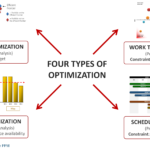
Cost-Value Optimization: this is the most popular type of portfolio optimization and utilizes efficient frontier analysis. The basic constraint of cost-value optimization is the portfolio budget. Work Type Optimization: this is a lesser known way of optimizing the portfolio, but corresponds to a more common term, portfolio balancing. The basic constraints of work-type optimization are categorical designations. Resource Optimization: this is another effective way of optimizing the portfolio and utilizes capacity management analysis. The basic constraint of resource optimization is human resource availability. Schedule Optimization: this type of optimization is associated with project sequencing, which relates to project interdependencies. The basic constraints of schedule optimization are project timing and project dependencies.
How is the efficient frontier used in PPM?

Traditional portfolio theory (used for financial portfolios) applies the concept of an “efficient frontier”, the points at which for a given amount of investment there is an optimal portfolio providing maximum benefit. Senior leaders need to keep in mind that using the efficient frontier helps them realize when money is being left on the table or pay too much for the business value they are getting. In some cases, for the same budget, a portfolio could generate far greater value. At a lower budget, a portfolio could generate equal value.
What are some of the challenges of utilizing project portfolio optimization?
There are a number of challenges companies need to be aware of in order to utilize portfolio optimization such as: getting leadership support of the optimization outputs, recognizing that portfolio optimization models cannot factor in all criteria, collecting enough data and having the right data at the right time, not having enough project options to choose from, developing the right cadence for portfolio optimization, and not having employees who know how to optimize the portfolio.
Never miss an Acuity PPM article
Don't take our word, listen to what others are saying:
"I find value in all of your articles."
"Your articles are interesting and I am sharing them with my team who have limited project knowledge. They are very useful."




